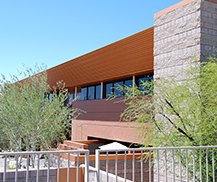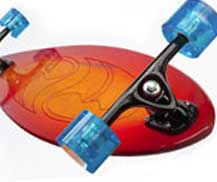Precision Coatings DTM 1300 Corrosion Resistant High Build Primer/Sanding Performance Primer
DTM primers from Precision are designed to provide corrosion protection and adhesion to a wide variety of substrates while retaining a smooth high-grade appearance. Precision's DTM primers are ultra-violet resistant so they can be used under metallic and iridescent finish coats which are translucent.
DTM 1300 is a high build, surface tolerant modified epoxy zinc-phosphate primer that is low VOC and LEED 2009 compliant. DTM 1300 high build primer can be sanded to achieve a smooth surface to be top coated with Precision Coatings PC3 acrylic aliphatic polyurethane, PC4 acrylic aliphatic polyurethane or PC5 siloxane for a fine finish.
Surface Preparation of Substrates Commonly Primed with DTM 1300 High Build Primer
The degree of adhesion and level of performance of atmospheric coatings is dependent on the degree of surface preparation. The properly prepared surface for coating must be sound and cohesively strong, clean and free of loose particles and contaminants, dry and exhibit a surface anchor profile for adhesion of performance coatings.
Surface preparation starts with the removal of contaminants including oils, grease, silicone, chloride and particulates. The prepared surface should be dry and provide a profile for mechanical bonding of the performance coating system. Surface preparation varies with the substrate. The most popular substrates coated with Precision Coatings DTM 1300 primer include previously coated substrates, carbon steel, galvanized steel, aluminum, fiberglass composites, and drywall.
Industry standards for surface preparation are established by organizations such as the Society of Protective Coatings (SSPC), NACE International, the International Standards Organization (ISO), and the International Concrete Repair Institute (ICRI).
Previously Coated Substrates
The existing coating must be sound and cohesively strong to form a foundation for the coating system to be applied. The existing coating surface shall be cleaned to remove all contaminants per SSPC-SP1. The surface shall be abraded with the appropriate abrasive paper to establish an anchor profile in the existing coating to obtain a mechanical adhesion for the application of the coating system. The selection of abrasive paper is dependent on the hardness of the existing coating. Hard surfaces may require silicon carbide abrasives of 80-180 grit, while softer coating films may only require aluminum oxide abrasives in the 150-340 grit range.
Prior to coating, the substrate must be clean and dry. Air and surface temperature must be above 50⁰ Fahrenheit and no more than 95⁰ Fahrenheit. Surface temperature must be at least 5⁰F (3⁰C) above the dew point.
Mild Carbon Steel
Steel must be cleaned of all contamination per SSPC-SP1. For atmospheric service, mill scale must be removed and the surface must be prepared. The most effective way to remove mill scale and prepare the carbon steel surface is to utilize SSPC SP-6 / ISO 8501-1 Sa 2 / NACE 3. The Commercial Blast Cleaning requires removal of mill scale, rust scale, coatings, oil, grease, dust, dirt, oxides, corrosion by-products, and other foreign matter.
Power tools can also be used to remove mill scale and prepare the carbon steel surface including the use of angle grinders fitted with abrasive discs, wire wheels or cup brushes, needle guns, and power sanders to remove loose rust and paint from the surface and in some cases to produce a profile.
- SSPC SP-3 Power Tool Cleaning requires the removal of all rust scale, mill scale, loose paint, and loose rust. The substrate should have a pronounced metallic sheen and be free of oil, grease, dirt, soil, chlorides, and other contaminants. The surface should not be polished smooth.
- SPC SP-11 Power Tool Cleaning to White Metal requires the surface to be free of all rust scale, mill scale, rust, paint, oxides, corrosion products, and other foreign matter. The surface must be roughened to a degree suitable for the specified paint system.
- SSPC SP-15 Commercial Power Tool Cleaning requires the surface to be free of all rust scale, mill scale, rust, paint, oxides, corrosion products, and other foreign matter but allows for up to 33% rust staining over the surface. The surface must be roughened to a degree suitable for the specified paint system.
Hand Tool Cleaning as detailed in SSPC-SP2 can be utilized when abrasive blasting and power tool cleaning is not possible or practical. The level of surface preparation and cleaning that can be accomplished with hand tool cleaning is limited and the service life of the coating system will be impacted. SSPC-SP2 requires the removal of all rust scale, mill scale, loose paint, and loose rust. The substrate should have a pronounced metallic sheen and be free of oil, grease, dirt, soil, chlorides, and other contaminants. The surface must be roughened to a degree suitable for the specified paint system.
Prior to coating, the substrate must be clean and dry. Air and surface temperature must be above 50⁰ Fahrenheit and no more than 95⁰ Fahrenheit. Surface temperature must be at least 5⁰F (3⁰C) above the dew point.
Hot Dipped Galvanized Steel and Galvanized Sheet Steel
Most galvanized steel is passivated to prevent wet staining and oxidation of the zinc film during transit and storage. Passivation treatments, including chromate passivation, must be removed prior to coating galvanized steel. Effective removal of the passivation film requires testing for passivation treatments per SSPC-SP16, sweep blasting with a non-ferrous abrasive or aggressively power tool cleaning components that cannot be effectively abrasive blasted and then retesting to ensure the zinc surface is fully exposed and all passivation has been removed from the galvanized steel.
Prior to coating, the substrate must be clean and dry. Air and surface temperature must be above 50⁰ Fahrenheit and no more than 95⁰ Fahrenheit. Surface temperature must be at least 5⁰F (3⁰C) above the dew point.
Aluminum
Aluminum substrates must be cleaned of all oils and preservatives. Aluminum substrates can be prepared for coating for atmospheric service by sweep blasting per SSPC-SP16 utilizing an angular non-metallic abrasive to produce a uniform and dense anchor profile, power tool/hand tool abraded aggressively utilizing silicon-carbide abrasive paper or chemically converted utilizing a chromating conversion coating process in accordance with Mil-DTL-5541.
Prior to coating, the substrate must be clean and dry. Air and surface temperature must be above 50⁰ Fahrenheit and no more than 95⁰ Fahrenheit. Surface temperature must be at least 5⁰F (3⁰C) above the dew point.
Anodized Aluminum
Anodized aluminum must be cleaned of all oils and preservatives. Aluminum alloys that are hard anodized have been electro-chemically treated to form a hard corrosion resistant non-porous film on the surface of the aluminum. Anodized aluminum substrates can be prepared for coating for atmospheric service by sweep blasting per SSPC-SP16 utilizing an angular non-metallic abrasive to produce a uniform and dense anchor profile. Anodized aluminum substrates can also be prepared using power tool and hand tool preparation methods, with aggressive rotational abrading of the substrate utilizing silicon-carbide abrasives from 80-100 grit. The anodized surface should be thoroughly inspected to confirm adequate anchor profile to provide a mechanical bond for the coating system.
Prior to coating, the substrate must be clean and dry. Air and surface temperature must be above 50⁰ Fahrenheit and no more than 95⁰ Fahrenheit. Surface temperature must be at least 5⁰F (3⁰C) above the dew point.
Coatable Fiberglass Composites
Fiberglass composites and plastics must be cleaned of all oils and mold release compounds. The substrate should be thoroughly abraded with 100 grit to 180 grit abrasive paper to provide an anchor profile for the mechanical adhesion of the coating system. Prior to application of the coating, clean the surface with a solvent such as acetone.
Prior to coating, the substrate must be clean and dry. Air and surface temperature must be above 50⁰ Fahrenheit and no more than 95⁰ Fahrenheit. Surface temperature must be at least 5⁰F (3⁰C) above the dew point.
Drywall
Tape and fill joints and divots with a recommended joint compound. Sand flush the joint compound with a fine abrasive. Do not disturb the paper facing and remove any frayed areas. Clean the surface of dust prior to priming.
Prior to coating, the substrate must be clean and dry. Air and surface temperature must be above 50⁰ Fahrenheit and no more than 95⁰ Fahrenheit. Surface temperature must be at least 5⁰F (3⁰C) above the dew point.
DTM 1300 High Build Modified Epoxy Primer
- DTM 1300 High Build Modified Epoxy Primer
- DTM 1300 Resin Safety Data Sheet
- DTM 1300 Cure Safety Data Sheet






